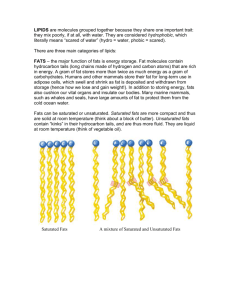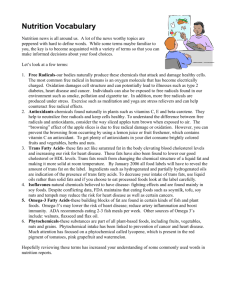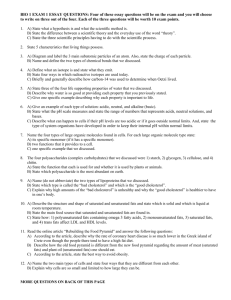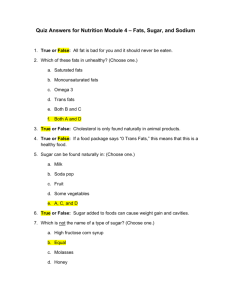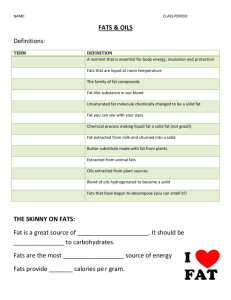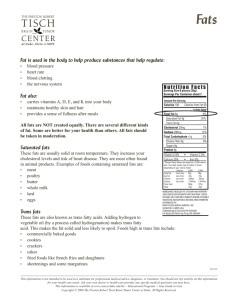Elements Of Human Nutrition
advertisement
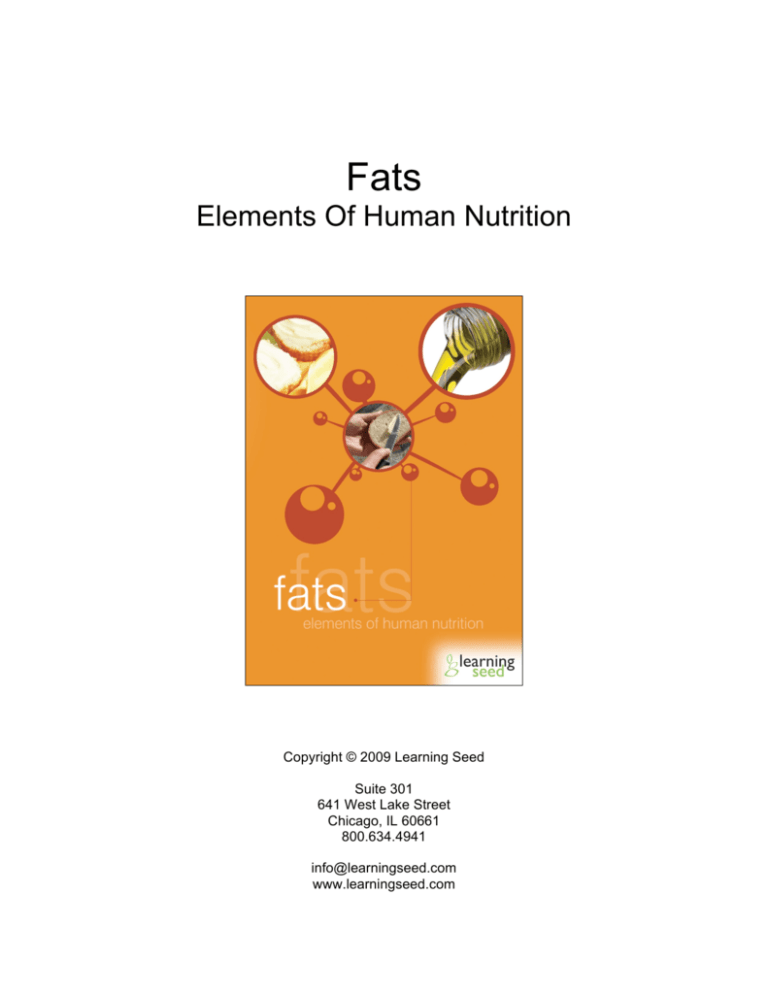
Fats Elements Of Human Nutrition Copyright © 2009 Learning Seed Suite 301 641 West Lake Street Chicago, IL 60661 800.634.4941 info@learningseed.com www.learningseed.com Fats Elements Of Human Nutrition Legal Niceties The Video Copyright © 2009 Learning Seed. This video program is protected under U.S. copyright law. No part of this video may be reproduced or transmitted by any means, electronic or mechanical, without the written permission of the Publisher, except where permitted by law. This Teaching Guide Copyright © 2009 Learning Seed. This teaching guide is copyrighted according to the terms of the Creative Commons non-commercial license (http://creativecommons.org/licenses/by-nc/2.5/). It may be reproduced, in its part or its entirety, for classroom use. No part of this guide may be reproduced for sale by any party. You are free: • • to copy, distribute, display, and perform the work. to make derivative works. Under the following conditions: • • • • Attribution. You must attribute the work to Learning Seed. Noncommercial. You may not use this work for commercial purposes. For any reuse or distribution, you must make clear to others the license terms of this work. Any of these conditions can be waived if you get permission from the copyright holder. Credits The Video This Teaching Guide Executive Producer: Kathleen O. Ryan Writer: Ixta Menchaca and Kathleen O. Ryan Producer: Kathleen O. Ryan Director: Michel Poglitsch Editor: Michel Poglitsch Narrator: Erin Anderson Compilation: Ixta Menchaca Copy Editor: Jennifer Smith Learning Seed Catalog and ISBN Numbers Questions or Comments? DVD We’d love to hear from you, whether you’d like a catalog, want to share your thoughts on one our titles, or have a question. Please contact us at: LS-1156-09-DVD ISBN 1-55740-543-3 Closed Captioning This program is closed-captioned. 2 Learning Seed Suite 301 641 West Lake Street Chicago, IL 60661 800.634.4941 info@learningseed.com Fats: Elements Of Human Nutrition Summary Lipids, or fats, are one of the nutrient groups vital to the human body. A lipid is a naturally occurring chemical compound that cannot be dissolved in water. Lipids perform several necessary functions for the body, but it is important to understand what positive and negative effects fats have on the body. Key points: 3 • There are different types of lipids including triglycerides, the fat most familiar as body fat and the fat in food. • Each triglyceride is a compound made up of glycerol, which is an alcohol, and fatty acids. • A fatty acid is an organic compound linking a fatty chain of carbon and hydrogen atoms on one end to an acid group at the other end. • The existence of double bonds between atoms in a fatty chain indicates that a fat is monounsaturated or polyunsaturated, also known as the “good” fats. Single bonds between atoms in a fatty chain mean the fat is saturated, or a “bad” fat. • Triglycerides serve several purposes including to supply energy, protect against temperature extremes and shock, and to help the body use carbohydrates and protein efficiently. • Most fat is stored in adipose tissue, found throughout the body underneath the skin and around organs, and can be used for energy at any time. • “Bad” fats include saturated fat, trans fat, and cholesterol. Saturated fat is fat filled with hydrogen, and is usually solid at room temperature. Trans fats are fats that are created by hydrogenating oils, or adding hydrogen to unsaturated fatty acids. Cholesterol is a waxy, soft substance found among body fat and around cells. • “Good” fats include monounsaturated and polyunsaturated fats. “Good” fats are usually liquid at room temperature. • Saturated fat, trans fat, and cholesterol pose serious health risks including obesity, diabetes, high cholesterol, and high blood pressure, and have been associated with cardiovascular disease and some types of cancer. • Monounsaturated fat and polyunsaturated fat are known to have the benefit of lowering blood cholesterol level and combating the effects of consuming “bad” fats. • Identifying “bad” fats and replacing them with “good” fats, or moderating their consumption are healthy measures to take in order to lower the risks of high blood cholesterol, high blood pressure, and other associated negative outcomes. Fats: Elements Of Human Nutrition Lipid Basics What is a lipid? Fats are part of a complex group of nutrients known as lipids. A lipid is a naturally occurring chemical compound that cannot be dissolved in water. There are different types of lipids, including triglycerides, the fat most familiar as body fat and the fat in food. On a basic chemical level, triglycerides are made up of carbon, hydrogen, and oxygen. Each triglyceride is a compound that is made up of glycerol and fatty acids. Glycerol is an alcohol made up of a three-carbon chain, which serves as a backbone for a triglyceride. A fatty acid is an organic compound made up of two parts: a fatty chain of carbon and hydrogen atoms on one end and an acid group at the other end. In the fatty chain, the atoms are linked or bonded together by sharing electrons. A double bond is created when atoms share two electrons. The existence of these double bonds is part of what makes fats “good” or “bad.” Triglycerides include monounsaturated and polyunsaturated fats known as the “good” fats, as well as saturated fat, trans fat, and cholesterol – the “bad” fats. Monounsaturated fats have one double bond between carbons. Polyunsaturated fats have two or more double bonds between carbons. Saturated fats have only single bonds. In the body, triglycerides serve a few purposes: • to supply energy, • to protect against temperature extremes, • to protect against shock, • and to help the body use carbohydrates and protein efficiently. Whether “good” or “bad,” fat provides more than twice the energy of carbohydrates and protein. This makes it a very efficient storage form of energy. When food is eaten, triglycerides enter the bloodstream where they are broken down by the enzyme lipoprotein lipase known as “LPL.” LPL breaks triglycerides into three parts: glycerol, fatty acids, and monoglycerides. These three building blocks of triglycerides then enter an adipose cell where they are put back together and stored as energy until the body requires it. Most fat is stored in adipose tissue, found throughout the body underneath skin and around our organs. While the majority of body cells can only hold small amounts of fat, adipose cells absorb and contain large amounts of fat. The fat stored in adipose tissue can be used for energy at any time. 4 Fats: Elements Of Human Nutrition “Bad” Fats What are “bad” fats? Saturated fat, trans fat, and cholesterol are the “bad” fats found in many food products and the ones to be careful of eating because of the health risks they can cause. Most “bad” fats, such as lard, shortening, mayonnaise, gravy, butter, and margarine, are solid at room temperature. Saturated fat is fat filled with hydrogen. It is found primarily in foods from animals but also in some tropical oils like coconut and palm oils. Foods like bacon, butter, chocolate, coconut, cream cheese, lard, fatty meat, and whole milk are high in saturated fat. Trans fats are fats that are created by hydrogenating oils. During this process, hydrogen atoms are added to monounsaturated and polyunsaturated fatty acids. This reduces the number of double bonds and makes the fats more saturated. In this way “good” fats can become “bad” fats. Hydrogenation is usually done commercially for baking and frying purposes and to ensure that products have long shelf lives. Trans fats can be found in fast foods or foods that are deep-fried, as well as cakes, chips, cookies, crackers, donuts, imitation cheese, margarine, and shortening. On food labels, the words “hydrogenated” and “partially hydrogenated” indicate the presence of trans fats. Cholesterol is a waxy, soft substance found among the fats in the body and around cells. It is needed by the body to form cell membranes and hormones, but too much cholesterol is unhealthy. Dietary cholesterol is found only in animal foods. Foods especially high in cholesterol include egg yolks, whole milk products, and fatty meats. What makes “bad” fats “bad”? Nutrition experts advise people to limit the intake of foods with “bad” fats like saturated and trans fats. Within these limits, cholesterol consumption is naturally low. But saturated fat, trans fat, and cholesterol pose serious health threats. Obesity is the most visible health concern linked to high fat consumption. Obesity, in turn, is linked to diabetes, high cholesterol, and high blood pressure. Obesity and diabetes have risen to epidemic proportions in some countries, especially among children and adolescents. Another of the major consequences of eating foods high in saturated fats and cholesterol is heart disease. Heart disease can even strike people who eat healthy foods or are thin. Cardiovascular disease is a result of saturated fat and cholesterol that has accumulated in arteries. The accumulations raise blood pressure and prevent normal blood flow. Thickened artery walls and clogged blood vessels can lead to serious medical consequences such as a stroke or heart attack. High fat intake is also associated with some types of cancer. 5 Fats: Elements Of Human Nutrition “Good” Fats What are “good” fats? There are two kinds of “good” fats: monounsaturated fat and polyunsaturated fat. Double bonds are present in the fatty acid chains of monounsaturated fat and polyunsaturated fat. When double bonds are formed, hydrogen atoms are eliminated preventing saturation as in saturated fats. “Good” fats tend to be liquid at room temperature, so most oils are part of the unsaturated fats group. Monounsaturated fats have one double bond in their fatty acid chain. Monounsaturated fats can be found in foods like avocado, canola, olive, peanut, and sesame oils, nuts, olives, and peanut butter. Polyunsaturated fats have more than one double bond in their fatty acid chain. Polyunsaturated fats are found in corn, cottonseed, safflower, and soybean oils, nuts, seeds, and fatty fish like herring, salmon, and tuna. What makes “good” fats “good”? In addition to being healthier than saturated fats, monounsaturated and polyunsaturated fats have the benefit of actually lowering blood cholesterol levels. Omega-3 fatty acids are forms of polyunsaturated fat that have been shown to produce several health benefits. The name “omega-3” refers to the position of the first double bond in the fatty acid present after the third carbon atom from the methyl end. Omega-3 fatty acids have been shown to reduce inflammation that helps to decrease cholesterol buildup in artery walls as well as pain from arthritis. Thus, eating foods rich in monounsaturated and polyunsaturated fats can help combat some of the effects of eating foods loaded with “bad” fats. 6 Fats: Elements Of Human Nutrition Guidelines For Eating Fats How much fat is healthy to eat? The United States Department of Agriculture has designated a system known as the food pyramid to help maintain a healthy diet. The food pyramid divides all foods into six groups and provides the recommended amount of each food group to eat. Whole grains should make up about 3 ounces of daily intake and can include whole grain bread, pasta, cereal, or rice. Fried, refined, or heavily salted or sweetened grains should be avoided or limited. Vegetable servings per day should be between 2 and 3 cups. Butter, cheese, and creamy sauces added to vegetables should be avoided or limited. Fruit servings per day should be approximately 2 cups. Raw fruits are better than frozen or canned fruits since valuable nutrients may be lost or heavy sweeteners are added in the process. The USDA also recommends approximately 3 cups from the milk group of foods in a daily diet. Because animal foods like cheese and milk have higher concentrations of fat, low-fat or non-fat versions of foods in this group are healthier choices. The meat and beans group of the food pyramid includes meat, poultry, fish, beans, eggs, and nuts. This group of foods is important because it provides the most protein in a person’s diet. Five to six ounces per day from the meat and beans group are recommended by the USDA. Lean cuts of meat and skinless poultry have less fat and are still protein-rich. Breaded and battered meats and fish should be avoided, as should processed meats like salami, bologna, and hot dogs, and other meats that not only have saturated and trans fats but added sodium, too. The last group that makes up the food pyramid is oils. Oils should only be a fraction of a person’s daily intake. Most people consume enough oil in the foods they eat. Some foods like avocados, olives, and nuts are particularly high in monounsaturated and polyunsaturated oils which are healthy and help the body lower blood cholesterol. The food pyramid and knowledge of “good” and “bad” fats can help in making healthy choices when deciding which foods to eat and which foods to avoid or limit. 7 Fats: Elements Of Human Nutrition Making Choices What are some ways to make healthier choices when it comes to fat? Every day, people are faced with choices that affect their fat intake. Many of these choices are subtle and go without much thought. However, certain words on restaurant menus signal higher fat content including: au gratin béarnaise butter sauce crispy creamy fried basted Other words can signal lower fat content and help identify healthier choices on menus. Some of these words are: au jus broiled boiled steamed baked poached roasted garden fresh Another way of limiting fat intake when dining out is to make requests that avoid adding fat to meals. Asking for butter, sauces, and dressings served on the side allows one to control how much is added. Simple replacements like substituting a plain baked potato for fries or a salad for cole slaw can also prevent unhealthy consumption of fats. Fresh fruit with low-fat or frozen yogurt, angel food cake, or fat-free cheesecake can replace fattier desserts. Opting to split a richer dessert with another person can also cut fat intake and satisfy a sweet tooth. Purchasing groceries for home preparation is a chance to make wiser food choices, too. Vegetables are a healthy choice, but primarily when they are steamed or raw and not covered in cream or butter that pack on the fat and calories. Steamed broccoli, for example, contains less than 1 gram of fat, but smothering that same broccoli with cheese sauce brings the fat count to 9 grams. Choosing to drink skim milk over whole milk is also a better choice because a cup of skim milk has less than 1 gram of fat, while whole milk has 5 grams. It is also important to make healthy decisions when it comes to selecting meat to prepare for meals. The leaner the cut of meat is, the less fatty it is, too. Opt for unmarbled cuts of beef that are designated “round” or “loin.” Consider choosing 95% fat-free varieties of ground beef or substitute ground chicken or turkey for ground beef. Salads are one of the best ways to limit excess intake of fat and calories whether dining out or eating at home, but they can be easily overtaken by fat and cholesterol if care is not taken to prepare them healthily. Avoiding heavy and creamy dressings like thousand island, blue cheese, or ranch is one of the easiest ways to keep a 8 Fats: Elements Of Human Nutrition salad low-fat. Steering clear of “fat traps” like chicken, tuna, or crab salads that usually contain fatty mayonnaise, and high sodium/saturated fat-filled bacon bits, cheese, and croutons are other smart moves. But again, all fats aren’t bad. In fact, good fats cannot only be added to a salad to clear arteries and boost overall health, but they can make a salad more delicious. To add extra crunch and some heart-healthy fats to a salad, sprinkle on a tablespoon of walnuts or sunflower seeds. For some added texture and zest, toss on a few avocado slices or olives. And a few tablespoons of olive oil and vinegar can be just as flavorful as a dressing without all the saturated fat and cholesterol of creamy or cheesy dressings. 9 Fats: Elements Of Human Nutrition Questions For Discussion 1. In the body, triglycerides serve several general functions. What are these functions? What are some specific instances in which triglycerides are crucial to supporting these functions? The four functions that triglycerides serve – to supply energy, to protect against temperature extremes, to protect against shock, and to help the body use carbohydrates and proteins efficiently. Any specific instances or personal experiences that fit any of these functions will suffice as appropriate responses. 2. What are the three types of “bad” fats and in what foods in a typical American meal can these fats be found? Describe three ways to limit “bad” fat intake on a daily basis. Saturated fat, trans fat, and cholesterol as the three types of “bad” fats. These fats are found in foods and food products, such as bacon, butter, cakes, chips, chocolate, coconuts, cream cheese, donuts, egg yolks, fatty meats, gravy, imitation cheese, lard, margarine, mayonnaise, shortening, or whole milk products. Various strategies for limiting or reducing “bad” fat intake include substituting certain forms of a food for another healthier version (such as swapping french fries for a baked potato), reducing fat by sharing or portion control, or choosing to prepare food with heart-healthy “good” fats instead of “bad” fats. 3. What is the link between eating “bad” fats and some of the health problems many Americans face today? What are some of the ways to prevent these health problems? The over-consumption of saturated fat, trans fat, and cholesterol has been linked to serious health problems including obesity, high blood pressure, heart disease, and cancer. Prevention methods of these problems range from addressing healthier diets, to law-making that regulates commercial food preparation, to increased education and awareness of nutrition. 4. What are the two types of “good” fats and in what foods can they be found? What positive health effects can they have for us? Monounsaturated fat and polyunsaturated fat as the two types of “good” fat. Foods containing “good” fats include avocados, fatty fish (i.e. herring, salmon, and tuna), nuts, peanut butter, seeds, and canola, corn, cottonseed, olive, peanut, safflower, sesame, and soybean oils. Positive health effects include lowering blood cholesterol, reducing arthritic pain, removing arterial build-up, and overall combating the effects of consuming “bad” fats. 10 Fats: Elements Of Human Nutrition Suggested Activities 1. Research recent menu changes at various fast food restaurants and how healthy these changes actually are for their customers. Compare and contrast the amount of saturated fat, trans fat, or cholesterol in meals at fast food restaurants and determine the healthiest menu selections. 2. Create a three-meal-per-day, week-long diet that limits or excludes “bad” fats while providing at least one meal per day that includes “good” fat. 3. Keep a detailed diary of the foods consumed over the course of five days. At the end of the five days, research the fat content of the various meals and determine their “bad” fat intake. Suggest healthier alternatives for future meals. 11 Fats: Elements Of Human Nutrition Research Project Research the typical diet of a country other than the United States. Compare the average intake of “good” and “bad” fats in this country’s staple foods or most popular meals to the fat intake in the average American diet. Address any similarities or differences this country’s population has in lifestyle and overall health with that of Americans. 12 Fats: Elements Of Human Nutrition Fats: Elements Of Human Nutrition Fill-In-The-Blank Fill in the blanks with the correct words from the bank at the bottom of the page. Fats are part of a complex group of nutrients known as ____________. These are naturally occurring chemical compounds that cannot be dissolved in water. There are different types of these compounds including ____________, the fat most familiar as body fat and the fat in food and made up of carbon, hydrogen, and ____________. Monounsaturated and polyunsaturated fats are known as ____________, while saturated fat, trans fat, and cholesterol are considered ____________. ____________ fats have one double bond between carbons. Two or more double bonds between carbons indicates the fats are ____________. ____________ have only single bonds. Fats provide several key functions in the human body including supplying energy, protecting against temperature extremes and shock, and helping the body use ____________ and proteins efficiently. As fats enter the bloodstream when eaten in food, they are broken down by the enzyme ____________ into three parts: glycerol, ___________, and monoglycerides. These three building blocks are then deposited into ____________ cells where they are stored until needed by the body for energy. While all fats, “good” or “bad” can be used for energy in the body, nutrition experts advise people to limit their intake of foods that contain saturated fats because they can lead to serious health problems such as obesity, high ____________, high blood pressure, and ____________ disease. Word Bank: polyunsaturated lipoprotein lipase cholesterol carbohydrates lipids saturated fats triglycerides adipose good fats oxygen cardiovascular fatty acids bad fats monounsaturated 13 Fats: Elements Of Human Nutrition Fats: Elements Of Human Nutrition Fill-In-The-Blank Answer Key Fill in the blanks with the correct words from the bank at the bottom of the page. Fats are part of a complex group of nutrients known as lipids. These are naturally occurring chemical compounds that cannot be dissolved in water. There are different types of these compounds including triglycerides, the fat most familiar as body fat and the fat in food and made up of carbon, hydrogen, and oxygen. Monounsaturated and polyunsaturated fats are known as good fats, while saturated fat, trans fat, and cholesterol are considered bad fats. Monounsaturated fats have one double bond between carbons. Two or more double bonds between carbons indicates the fats are polyunsaturated. Saturated fats have only single bonds. Fats provide several key functions in the human body including supplying energy, protecting against temperature extremes and shock, and helping the body use carbohydrates and proteins efficiently. As fats enter the bloodstream when eaten in food, they are broken down by the enzyme lipoprotein lipase into three parts: glycerol, fatty acids, and monoglycerides. These three building blocks are then deposited into adipose cells where they are stored until needed by the body for energy. While all fats, “good” or “bad” can be used for energy in the body, nutrition experts advise people to limit their intake of foods that contain saturated fats because they can lead to serious health problems such as obesity, high cholesterol, high blood pressure, and cardiovascular disease. 14 Fats: Elements Of Human Nutrition Fats: Elements Of Human Nutrition Multiple Choice Worksheet Circle the best available answer for each of the following: 1) Saturated fat is considered “saturated” because it is fat filled with: a) oxygen b) carbohydrates c) hydrogen d) proteins 2) “Bad” fats include all these, EXCEPT: a) trans fat b) polyunsaturated fat c) cholesterol d) saturated fat 3) Monounsaturated fats have this many double bonds in their fatty acid chains: a) 0 b) 1 c) 2 d) 3 4) The waxy, soft substance found among the fats in the body and around cells is: a) glycerol b) cholesterol c) hydrogen d) protein 5) Approximately this amount of daily intake from the meat and beans group is recommended by the USDA: a) 2-3 ounces b) 3-4 ounces c) 5-6 ounces d) 7-8 ounces 15 6) Over-consumption of “bad” fats has been linked to these health concerns, EXCEPT: a) obesity b) cardiovascular disease c) muscle loss d) high blood pressure 7) Coconut and palm oils are considered: a) polyunsaturated fats b) trans fats c) saturated fats d) monounsaturated fats 8) These words often indicate foods prepared with less-fat, EXCEPT: a) basted b) boiled c) broiled d) steamed 9) The alcohol made up of a three carbon chain and serves as a backbone for a triglyceride is: a) cholesterol b) hydrogen c) glycerol d) LPL 10) This salad topping contains heart-healthy “good” fat: a) croutons b) avocado slices c) bacon bits d) crab salad Fats: Elements Of Human Nutrition Fats: Elements Of Human Nutrition Multiple Choice Worksheet Answer Key Circle the best available answer for each of the following: 1) Saturated fat is considered “saturated” because it is fat filled with: a) oxygen b) carbohydrates c) hydrogen d) proteins 2) “Bad” fats include all these, EXCEPT: a) trans fat b) polyunsaturated fat c) cholesterol d) saturated fat 3) Monounsaturated fats have this many double bonds in their fatty acid chains: a) 0 b) 1 c) 2 d) 3 4) The waxy, soft substance found among the fats in the body and around cells is: a) glycerol b) cholesterol c) hydrogen d) protein 5) Approximately this amount of daily intake from the meat and beans group is recommended by the USDA: a) 2-3 ounces b) 3-4 ounces c) 5-6 ounces d) 7-8 ounces 16 6) Over-consumption of “bad” fats has been linked to these health concerns, EXCEPT: a) obesity b) cardiovascular disease c) muscle loss d) high blood pressure 7) Coconut and palm oils are considered: a) polyunsaturated fats b) trans fats c) saturated fats d) monounsaturated fats 8) These words often indicate foods prepared with less-fat, EXCEPT: a) basted b) boiled c) broiled d) steamed 9) The alcohol made up of a three carbon chain and serves as a backbone for a triglyceride is: a) cholesterol b) hydrogen c) glycerol d) LPL 10) This salad topping contains heart-healthy “good” fat: a) croutons b) avocado slices c) bacon bits d) crab salad Fats: Elements Of Human Nutrition Fats: Elements Of Human Nutrition Quiz Match the words in the first column to the best available answer in the second column. _____ Fat that is created by hydrogenating oils. 1) more than 1 _____ One of the “good” fats, its name refers to the position of the first double bond of the fatty acid. 2) cholesterol _____ The kind of fat that can only be found in animal food products. 3) adipose _____ The fat most familiar as body fat and the fat in food. _____ The number of double bonds polyunsaturated fats have in their fatty acid chains. 5) trans fat _____ The tissue in which most human body fat is stored. 6) triglycerides _____ The daily amount of cups from the milk group of the food pyramid the USDA recommends. 7) Omega-3 _____ The enzyme that breaks down triglycerides for storage. 8) 3 17 4) lipoprotein lipase Fats: Elements Of Human Nutrition Fats: Elements Of Human Nutrition Quiz Answer Key Match the words in the first column to the best available answer in the second column. 5) trans fat Fat that is created by hydrogenating oils. 7) Omega-3 One of the “good” fats, its name refers to the position of the first double bond of the fatty acid. 2) cholesterol The kind of fat that can only be found in animal food products. 6) triglycerides The fat most familiar as body fat and the fat in food. 1) more than 1 The number of double bonds polyunsaturated fats have in their fatty acid chains. 3) adipose The tissue in which most human body fat is stored. 8) 3 The daily amount of cups from the milk group of the food pyramid the USDA recommends. 4) lipoprotein lipase The enzyme that breaks down triglycerides for storage. 18 Fats: Elements Of Human Nutrition Glossary Adipose tissue Tissue found throughout the body underneath skin and around organs that absorbs and contains large amounts of fat until needed by the body for energy. Cholesterol A waxy, soft substance found among the fats in the body and around cells. It is needed by the body to form cell membranes and hormones. Dietary cholesterol is found only in animal foods. Fatty acids An organic compound made up of two parts: a fatty chain of carbon and hydrogen atoms on one end and an acid group at the other end. Glycerol An alcohol made up of a three carbon chain, which serves as a backbone for a triglyceride. Lipid A naturally occurring chemical compound that cannot be dissolved in water. There are different types of lipids, including triglycerides, the fat most familiar as body fat and the fat in food. Lipoprotein lipase An enzyme that breaks down triglycerides into glycerol, fatty acids, and monoglycerides for storage in adipose cells. Monounsaturated fats Fats that have one double bond between carbons. Polyunsaturated fats Fats that have two or more double bonds between carbons. Saturated fats Fats that only have single bonds between carbons and filled with hydrogen. Trans fats Fats created by hydrogenating oils. During this process, hydrogen atoms are added to monounsaturated and polyunsaturated fatty acids. This reduces the number of double bonds and makes the fats more saturated. Triglycerides The fat most familiar as body fat and the fat in food. Triglycerides are made up of carbon, hydrogen, and oxygen. Each triglyceride is a compound that is made up of glycerol and fatty acids. 19 Fats: Elements Of Human Nutrition For More Information… General Nutrition Books Carter J., Wiecha J., Peterson K., Nobrega S., and Gortmaker S.L. Planet Health: An Interdisciplinary Curriculum for Teaching Middle School Nutrition and Physical Activity, Second Edition. Champaign: Human Kinetics. 2007. ISBN 9780736069182 Cheung L.W., Dart H., Kalin S., Gortmaker S.L. Eat Well and Keep Moving: An Interdisciplinary for Teaching Upper Elementary School Nutrition and Physical Activity, Second Edition. Champaign: Human Kinetics. 2007. ISBN 9780736069403 Clark, Nancy. Nancy Clark’s Sports Nutrition Guide Book, Fourth Edition. Champaign: Human Kinetics. 2008. ISBN 9780736074155 U.S. Department of Health and Human Services. A Healthier You: Based on the Dietary Guidelines for American’s. U.S. Government Printing Office. 2005. ISBN 9780160725258 Duffy, Roberta. American Dietetic Association’s Complete Food and Nutrition Guide, Third Edition. Wiley Publishing, Inc. 2006. Kirby, Jane. Dieting for Dummies, Second Edition. Wiley Publishing, Inc. 2004. Deen, D. and Hark, L. Nutrition for Life. D.K. Publishing, Inc. 2005. Zied, E. with Winter, R. So What Can I Eat? How to Make Sense of the New Dietary Guidelines for American’s and Make Them Your Own. Wiley Publishing, Inc. 2006. 20 Fats: Elements Of Human Nutrition Fats Websites Cholesterol Medline Plus http://www.nlm.nih.gov./medlineplus/cholesterol.html Cholesterol And Diet Medline Plus http://www.nlm.nih.gov/medlineplus/ency/article/002472.htm Dietary Fat and Physical Activity: Fueling the Controversy Gatorade Sports Science Institute http://www.gssiweb.com/Article_Detail.aspx?articleid=64&level=3&topic=1 Dietary Fats Medline Plus http://www.nlm.nih.gov/medlineplus/dietaryfats.html Dietary Guidelines For Americans 2005 U.S. Department of Health and Human Services http://www.health.gov/dietaryguidelines/dga2005/document/html/chapter6.htm Fat – Medical Encyclopedia Medline Plus http://www.nlm.nih.gov/medlineplus/ency/article/002468.htm Fats 101 American Heart Association http://www.americanheart.org/presenter.jhtml?identifier=3045789 Healthy Weight Department of Health and Human Services – Centers for Disease Control and Prevention http://www.cdc.gov/nccdphp/dnpa/healthyweight/index.htm Nutrition For Everyone Department of Health and Human Services – Centers for Disease Control and Prevention http://www.cdc.gov/nccdphp/dnpa/nutrition/nutrition_for_everyone/basics/fat.htm Triglycerides Medline Plus http://www.nlm.nih.gov/medlineplus/triglycerides.html 21 Fats: Elements Of Human Nutrition General Nutrition Websites Kids Health - Kids http://kidshealth.org/kid Kids Health - Teen http://kidshealth.org/teen Kids Health - Parent http://kidshealth.org/parent Arbor Nutrition Guide http://arborcom.com Mayo Clinic - Food And Nutrition www.mayoclinic.com/health/food-and-nutrition/NU99999 Gatorade Sports Science Institute www.gssiweb.com National Dairy Council www.nationaldairycouncil.org American Dietetic Association – Eat Right www.eatright.org American Heart Association www.americanheart.org United States Department of Agriculture – My Pyramid www.mypyramid.gov WebMD www.webmd.com Harvard – School of Public Health www.hsph.harvard.edu/nutritionsource Centers for Disease Control and Prevention – Healthy Living http://cdc.gov./HealthyLiving 22 Fats: Elements Of Human Nutrition

